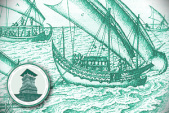The Maritime World of the traditional Nusantara included the coastal Javanese, the Madurese, Balinese, Malay, Buginese and other ethnic groups or Orang Laut who dominated the archipelagic seas. Their presence is reflected in many archival documents. Different boat types such as the sampan, perahu, pencalang, gonting and paduakan ventured out to different ports in an age-old system of trading networks.

War vessels like the lancaran, the Arabo-Persian ghurab and ghali (a galley which could be 150 feet long) reflect Ottoman naval influences, particularly in Aceh. Although these ships could pose a serious threat to European ships, the traditional ports and trading networks of the Nusantara fell increasingly under the influence of European maritime trade and naval power from the mid-sixteenth century (the Portuguese) and from the early seventeenth century (English, Dutch, and French). This power was exercised through the presence of heavily armed ships and patrol vessels like the challop in the Sunda and Melaka Straits. The growth of Chinese shipping after 1684 also shaped maritime trading patterns and ways of transporting goods and people. Many traditional Asian maritime patterns and activities persisted, while others were simply transformed. This section brings us into contact with Asian shipping, cargoes, crews and voyages. Here we are in search for the mualim (steersmen, pilots) and nakhoda (ship’s captains), and the syahbandars(harbourmasters) and laksamana (admirals).
Tidak ada komentar:
Posting Komentar